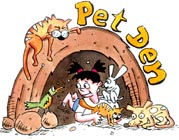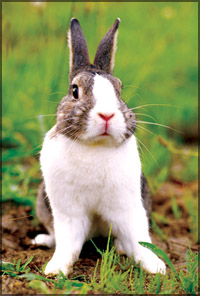 Looking after your pet rabbit
Are
you looking for a pet? Do you want a particular type of pet that is not
very common? Why don't you have a rabbit then? Do you know that rabbits
are growing in popularity as house pets? As social creatures as well as
being active and playful, they have the ability to be wonderful pets.
The life expectancy of rabbits varies with the breed; however, it
could generally be between five and 15 years. Rabbits make excellent
pets, and offer a wonderful alternative in situations where it could be
difficult to keep dogs or cats.
Rabbits are clean, tame and intelligent. However, they still require
responsible care and daily attention. Their basic needs are a warm, dry
cage, being kept clean, wholesome food and fresh water to drink. You can
also teach rabbits to use a litter box.
teach rabbits to use a litter box.
Rabbits would be safe indoors or outdoors, as long as they have
protection from rain, wind and direct sunlight. They should be examined
daily for any signs of illness. Make sure they are drinking water and
eating their food daily. Watch out for signs of fleas or mites and check
for diarrhoea or any unusual lumps. Their eyes should appear bright.
Rabbits should be handled regularly so they become familiar to human
hands. Then, if and when they do require medical attention, it will not
be a distressing experience for them to be handled by humans.
If your rabbit is sneezing excessively, and appears to have a very
wet nose, or if there are signs of nasal discharge on the inside of the
front feet from rubbing its nose and eyes, consult a veterinarian. The
leading cause of death in the female rabbit is uterine cancer.
Unfortunately, this disease has often spread to other organs by the
time it is diagnosed. Young females should be spayed (sterilised)
between six months and two years of age, to prevent this disease. Unless
the animal is to be used for breeding, it is recommended that she be
spayed.
When you are handling a rabbit, always hold it with both hands, to
support its hind legs and prevent it struggling. Fractures of the lumbar
spine happen frequently as a result of improper handling.
Rabbits have a low ratio of skeletal mass to muscle mass, and their
strong hind legs can exert enough pressure on the spine to cause
fractures, if mishandled.
Rabbits experience a molting process once a year, where they shed
their coats and grow a new one.
Usually, this is a trouble-free process, which begins over the back
and progresses towards the rump(tail end, buttocks) and goes down the
sides. At the same time, the hair on the feet, face, and ears is shed.
The molt continues down to the underside and tail, ending on the chest.
Regular grooming is essential to free the coat of dead hairs and
accelerate the molting process. A soft brush or bare hands may be used.
The rabbit's coat may be kept clean with a little talcum powder or corn
flour rubbed well into the coat and then brushed out.
With proper care and management, your pet rabbit will live a long and
healthy life, providing years of companionship to you.
Compiled by Janani Amarasekara
|
